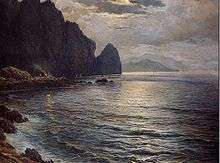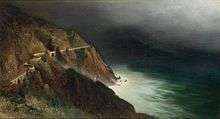Karl Wilhelm Diefenbach





Karl Wilhelm Diefenbach (February 21, 1851, Hadamar, Duchy of Nassau – December 15, 1913, Capri) was a German painter and social reformer.
Life
Diefenbach was a pioneer of nudism and the peace movement. His country commune, Himmelhof, in Ober Sankt Veit near Vienna (1897–1899) was one of the models for the reform settlement Monte Verità in Ascona.[1] His ideas included life in harmony with nature and rejection of monogamy, turning away from any religion (although he was a follower of theosophy), and a vegetarian diet.[2] When his commune went bankrupt, he moved to Capri and stayed there for the rest of his life.
As a painter, Diefenbach was an independent representative of Symbolism. There has been a museum of his works in Certosa di San Giacomo on Capri since 1974.[3]
Exhibitions
- October 29, 2009 to January 31, 2010: Museum Villa Stuck in Munich
See also
References
- ↑ Müller, Hermann (2011). Himmelhof. Urzelle der Alternativbewegung, 1897-1899. Recklinghausen: Umbruch-Verlag. p. 210. ISBN 978-3-937-72608-3.
- ↑ "The writers, artists and aristocrats who fell in love with Capri". Karl Wilhelm Diefenbach (Hadamar 1851 - Capri, 1913). Capri.Net. Retrieved 30 November 2013.
- ↑ in Campania: Certosa di San Giacomo – Museo Diefenbach. Retrieved 30 November 2013.
Sources
- Alisio, Giancarlo: Karl Wilhelm Diefenbach 1851-1913. Dipinti da collezioni private. Electa Napoli. Edizioni La Conchiglia,1995.
- Allgemeines Künstlerlexikon Bd. 27, 2000, S. 221.
- Buchholz, Kai u. a. (Hrsg.): Die Lebensreform. Entwürfe zur Neugestaltung von Leben und Kunst um 1900. 2 Bände. Verlag Haeusser, Darmstadt 2001. ISBN 3-89552-077-2
- Karl Wilhelm Diefenbach. Per aspera ad astra: Schattenfries und Dichtung "Seines Lebens Traum & Bild" Anmerkungen von Claudia Wagner. Recklinghausen, Umbruch-Verlag, 2. Auflage, 2007. Broschur, 75 S. mit Abb. ISBN 978-3-937726-01-4
- Eley, Geoff and Retallack, James (eds.): Wilhelminism and its Legacies. German Modernities, Imperialism, and the Meanings of Reform, 1890-1930. Berghahn, New York/Oxford, 2003.
- Frecot, Janos ; Geist, Johann Friedrich ; Kerbs, Diethart: Fidus, 1868-1948. Zur ästhetischen Praxis bürgerlicher Fluchtbewegungen. München: Rogner und Bernhard bei Zweitausendeins; Affoltern: Buch 2000. ISBN 3-8077-0359-4
- Grisko, Michael (Hrsg.): Freikörperkultur und Lebenswelt. Studien zur Vor- und Frühgeschichte der Freikörperkultur. kassel university press, Kassel 1999. ISBN 3-933146-06-2
- Hammer, Claudia: Karl Wilhelm Diefenbach, 1851-1913. Ausstellungskatalog der Galerie Konrad Bayer, München 2003.
- Kobel, Stefan: Karl Wilhelm Diefenbach. Der Maler als Gesamtkunstwerk. Magisterarbeit, Düsseldorf 1997.
- Müller, Hermann (Hrsg.): Meister Diefenbachs Alpenwanderung. Ein Künstler und Kulturrebell im Karwendel 1895/1896. Umbruch-Verlag, Recklinghausen 2004. ISBN 3-937726-00-4
- Richter, Peter: Der Jesus von München, Frankfurter Allgemeine Sonntagszeitung vom 29. November 2009, S. 23
- Schiano, Manuela: Alla ricerca della Sonnenland: la missione di Karl Wilhelm Diefenbach, «Heliopolis»,1, settembre- dicembre 2002, pp. 89–103.
- Schiano, Manuela: Conoscere K.W.Diefenbach, «Conoscere Capri», 7, 2008.
- Schiano, Manuela: K.W.Diefenbach. Un artista senza patria, Tesi di laurea in storia moderna, Università degli studi di Napoli "Federico II", Napoli 2001.
- Schiano, Manuela: Una stanza chiamata museo, «Nuova Museologia», 7, dicembre 2002, pp. 23–26.
- Spaun, Paul von (Hrsg.): Zum Fall Diefenbach. Triest 1899.
- Todisco, Silvana: K. W. Diefenbach. Omnia vincit ars. Electa Napoli, Neapel 1988.
- Wagner, Claudia: Der Künstler Karl Wilhelm Diefenbach (1851-1913) - Meister und Mission. Mit einem Werkkatalog aller bekannten Ölgemälde. Dissertation am Fachbereich Kunstgeschichte der Freien Universität Berlin, 2005. http://www.diss.fu-berlin.de/2007/652
- Wagner, Claudia, Herrmann Müller, Noemi Smolik, and Marina Schuster (2009): Karl Wilhelm Diefenbach (1851–1913): Lieber sterben, als meine Ideale verleugnen!. (2nd ed., 2011.) Edition Minerva, München, 239 pp. ISBN 978-3938832769
External links
| Wikimedia Commons has media related to Karl Wilhelm Diefenbach. |